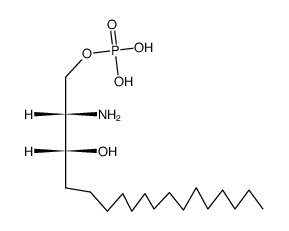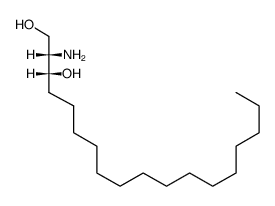19794-97-9
| Name | sphinganine 1-phosphate |
|---|---|
| Synonyms |
Sphinganine 1-phosphate
D-erythro-sphinganine-1-phosphate D-erythro-Dihydro-D-sphingosine-1-phosphate |
| Description | Sphinganine 1-phosphate (D-erythro-Dihydrosphingosine 1-phosphate) is a polar sphingolipid metabolite that regulates cell migration, differentiation, survival and complex physiological processes[1]. |
|---|---|
| Related Catalog | |
| Target |
Human Endogenous Metabolite |
| In Vitro | Sphinganine 1-phosphate (S1P) is a potent signaling molecule involved in cell stress responses, cancer, angiogenesis and lymphocyte trafficking. Sphinganine 1-phosphate functions primarily by activating a subgroup of the endothelial differentiation gene (EDG) family of G-protein coupled cell surface receptors. Sphinganine 1-phosphate has opposite effects in the regulation of cell metabolism. Sphinganine 1-phosphate regulates skeletal muscle differentiation and regeneration[1]. Sphinganine 1-phosphate (S1P) is involved in cancer. Sphinganine 1-phosphate regulates processes such as inflammation, which can drive tumorigenesis; neovascularization, which provides cancer cells with nutrients and oxygen; and cell growth and survival[1]. Sphinganine-1-Phosphate (1 μM) phosphorylates ERK MAPK, Akt, and HSP27 and induces HSP27 in human renal endothelial cells[2]. Cell Viability Assay[2] Cell Line: Human renal endothelial cells or human kidney proximal tubule (HK-2) cells Concentration: 1 μM Incubation Time: 2 or 4 hours Result: Induced HSP27 mRNA in cultured human renal endothelial cells. Phosphorylated ERK MAPK and AKT in human renal endothelial cells in a time-dependent manner. Phosphorylated and induced HSP27. |
| In Vivo | Sphinganine 1-phosphate can enhance wound healing in diabetic mice[1].Sphinganine 1-phosphate provides renal and hepatic protection after liver ischemia and reperfusion (IR) injury in mice through selective activation of S1P1 receptors and pertussis toxin-sensitive G-proteins with subsequent activation of ERK and Akt. Sphinganine 1-phosphate (administered 0.1 mg/kg i.v. immediately before reperfusion and 0.2 mg/kg s.c. 2 h after reperfusion) protects against hepatic and renal injury after liver IR[2]. Animal Model: Male C57BL/6 mice (20-25 g)[2] Dosage: 0.1 mg/kg Administration: Administered i.v. immediately before reperfusion and 0.2 mg/kg s.c. 2 h after reperfusion Result: The plasma level of alanine aminotransferase (ALT) and Creatinine (Cr) was 80±6 U/L and 0.46±0.05 mg/dL, respectively. The increases in ALT (7474±557 U/L) and Cr (0.55±0.05 mg/dL) were significantly suppressed at 24 h after reperfusion in mice treated with 0.1 mg/kg i.v. before reperfusion and 0.2 mg/kg s.c. 2 h after reperfusion. |
| References |
| Molecular Formula | C18H40NO5P |
|---|---|
| Molecular Weight | 381.48800 |
| Exact Mass | 381.26400 |
| PSA | 122.82000 |
| LogP | 4.96550 |
| Vapour Pressure | 2.66E-14mmHg at 25°C |
| HS Code | 2922509090 |
|---|
|
~% 
19794-97-9 |
| Literature: Weiss,B. Journal of Organic Chemistry, 1961 , vol. 26, p. 491 - 497 |
| Precursor 1 | |
|---|---|
| DownStream 0 | |
| HS Code | 2922509090 |
|---|---|
| Summary | 2922509090. other amino-alcohol-phenols, amino-acid-phenols and other amino-compounds with oxygen function. VAT:17.0%. Tax rebate rate:13.0%. . MFN tariff:6.5%. General tariff:30.0% |
